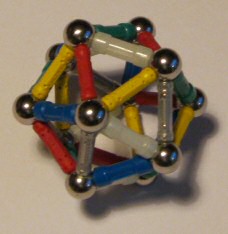Regular maps and multiply-transitive groups
This page describes a way to derive multiply-transitive groups from
regular maps.
It is most likely to work if the regular map that we start with
- has triangular faces,
- has an even number of vertices,
- has a vertex multiplicity of 1 (i.e. no two edges connect the same pair of vertices)
The process is as follow.
- Take a regular map R, preferably satisfying most of the above conditions
- Find a subset of edges of R, we will call it S, such that the
rotational symmetry group of S acts half-edge-transitively on S, and
such that no two edges of S share a vertex. Note that by Lagrange's theorem,
[rsg(S)] must divide [rsg(R)], and so the number of edges of S
must divide the number of edges of R.
- Generally, try to choose S as large as possible, at or close to its upper
limit of half the number of vertices of R. (If the result is to be sharply
3-transitive, at most 2 vertices can remain fixed by any element.)
- Find the group, permuting the vertices of R, that is generated by the rotational
symmetry group of R, plus the involution which interchanges the vertices at the
ends of each edge in S.
Examples
| Regular map R | rsg(R) | Instruction set | size of S | rsg(S) | R–S | Group obtained | degree of
transitivity | Size of set
permuted |
|---|
| Octahedron | S4 |
<1,2> | 3 | D6 | Triangular prism | S5 | sharply 3 | 6 |
| Cube | S4 |
<1,2> | 3 | D6 | 3-hosohedron | PGL(2,7) | sharply 3 | 8 |
| Icosahedron | A5 |
<4,1> | 5 | D10 | pentagonal prism capped with pyramids | PGL(2,11) | sharply 3 |
12 |
| dual of Dyck map | (96 elements) |
<5,4 / 4,3> | 6 | C3 | | M12 | sharply 5 |
12 |
| dual of Klein map | PSL(2,7) |
<2,4 ; 4,3> | 12 |
S4 | | M24 | 5 | 24 |
In the table above,
| rsg | | denotes rotational symmetry group |
| instruction set | | is explained below |
| R–S | | denotes the (usually) non-regular map formed
by removing the edges of S from R |
Instruction sets

It is useful to be able to specify a particular set S. We do this by an
"instruction set" which shows how to get from one of S's member edges to
another. A typical instruction set looks like this: <1,3>.
An instruction set <m,n> means "travel along the edge you
have selected until you reach a vertex; select the mth edge from that vertex,
counting from the left; continue to the next vertex; select the nth edge from
that vertex, counting from the left."
The illustration shows an icosahedron, with a set S in yellow (and five other
conjugate sets shown in five other colours). This S could be specified as
<4,1> or as <1,2>.
A semicolon indicates a choice. Thus <2,4 ; 4,3> means "take
the 2nd edge then the 4th edge, or take the 4th edge then the 3rd edge".
A solidus indicates alternation. Thus <5,4 / 4,3> means
"there are two classes of edge in S. From a member of the first class use
<5,4> to reach a member of the second class. From a
member of the second class use <4,3> to reach a member
of the first class." This results in an S which is not as defined above,
not being half-edge transitive.
More on Regular Maps
.
